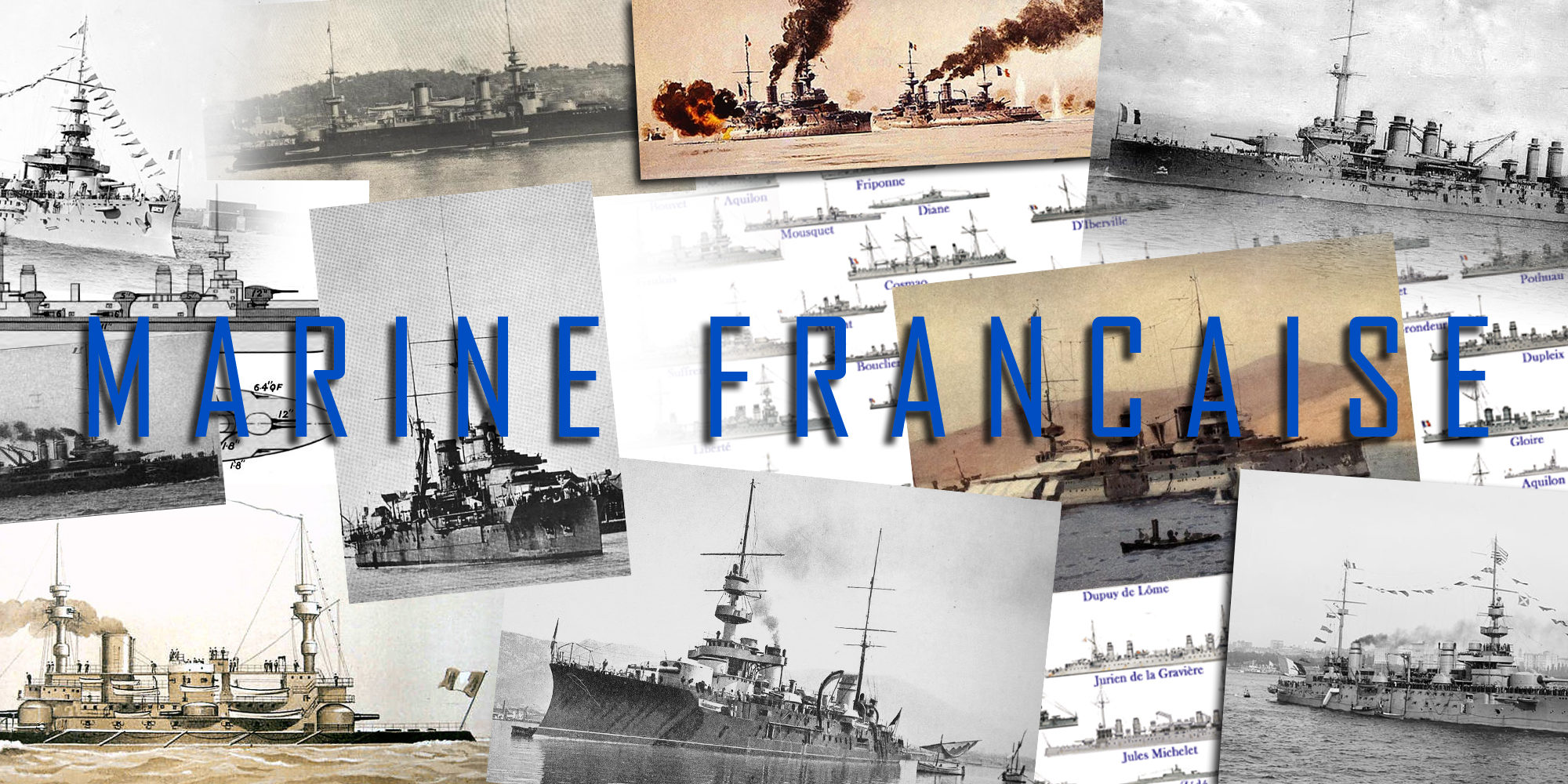
The French Navy in WWI
 “La Royale”, 16 battleships, 40 cruisers, 100+ destroyers & 400+ misc.
“La Royale”, 16 battleships, 40 cruisers, 100+ destroyers & 400+ misc.
An introduction: Origins to the XIXth Century
“La Royale”, literally, “The Royal” (navy) is still the old nickname of the French Navy today -the most conservative of the three army branches- dating back from Francis the 1st, then in open rivalry with Henry VIII, it was later expanded and formalized in 1624 by Cardinal of Richelieu (Louis XIII) and later by able ministers of Louis XIV, Colbert in particular. With the revolution, most of the officers (appointed nobles) were comprehensively guillotined or fled the country. Under Napoleon, the Navy was in poor shape due to neglect and had to ally with the the Spanish Armada. This was disaster first at Abukir then Trafalgar in some of the most defining moments of British history and fateful for the world.
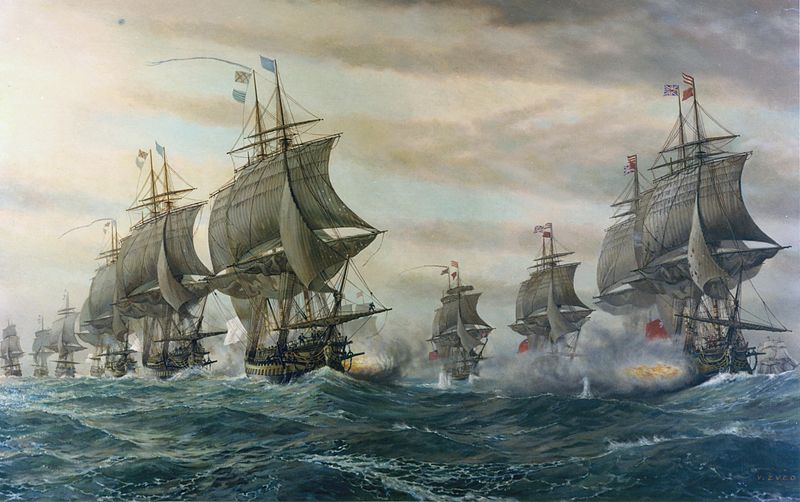
Battle of Virginia Capes (Chesapeake), 1782. The Franco-British Naval Rivalry was about empire building worldwide in the XVIIIth century, and one of its consequences was the birth of the United States.
The French fleet had been in the XVIIth and even more at the time of the seven years war (under louis XV) arguably on par with the Royal Navy at least in terms of numbers. Admiral De Grasse intervention on the Chesapeake bay and Yorktown famously helped George’s Washington’s army besieging Lord Cornwallis which had to surrender, giving in effect the United States its independence. However, after the Napoleonic Wars, despite of light constructions, it has fallen well behind its former glory. The situation was long maintained to a gradual return to “half-parity” and the industrial revolution, but the French Navy was still well above most countries at that time, many small divided kingdoms (Italy, Germany etc.).
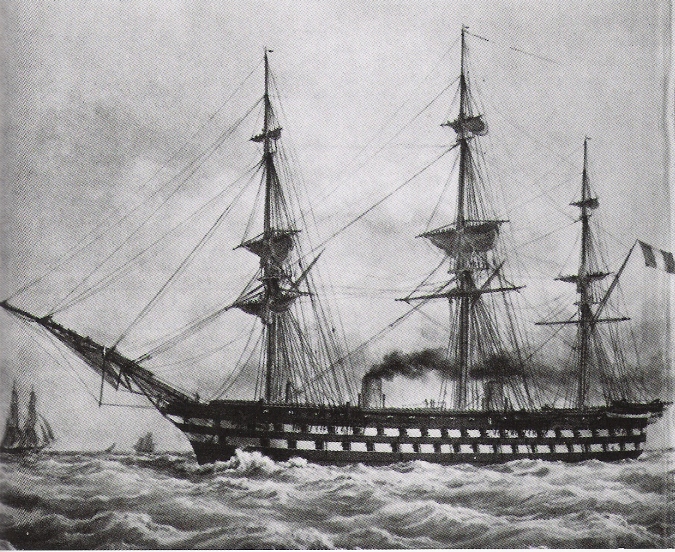
Napoleon, the first screw-propelled steamship of the line (cc)
In the 1830s was invented the Paixhans gun, an explosive shell that quickly proved devastating (battle of Vera Cruz 1838) and was widely adopted as a standard. In 1849, talented naval engineer Dupuy De Lôme created the first sea-going first steam-propelled ship of the line, the Napoleon, screw-propelled. It was tested in Crimea, as well as armoured floating batteries. The Royal Navy was not long to follow and both navies launched in a frenzy of steamships constructions or reconversions until the 1870s. In between, De Lôme stroke again, with the first sea-going ironclad, the Gloire in 1859, and revealed later a working submarine, the Plongeur (“Plunger”) in 1863.
Given the state of French naval industry at that stage, the Gloire was only a modest converted frigate, cladded with armour plates from the waterline to the upper deck over the wooden hull.
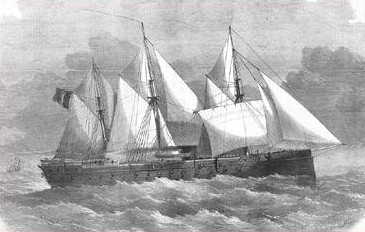
Engraving of the first sea going ironclad La Gloire, 1859. (cc)
The British already gathered crucial intelligence on the matter and launched the HMS warrior, the first sea-going all-metal ironclad. Soon a new arms race began, the one that will led to ww1 battleships. Later on in 1876, France would launch the first all-steel battleship, Le redoutable, and in 1887, the Dupuy de lôme, claimed to be the first modern armoured cruiser.
France’s mindset was influenced largely by the Republican ideology, positivism, great confidence in science. Victorian Great Britain and the other hand, had a practical fleet made as large as all other navies combined, and in general much more conservative and pragmatic in its approach to innovation.
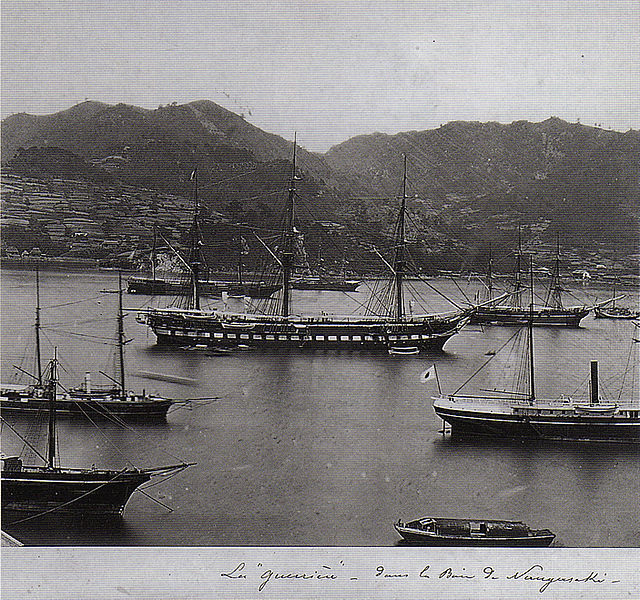
La Guerriere, frigate in the Tonkin 1866 (cc)
Articles Published and Upcoming
- Amiral Charner class armoured cruisers (1892)
- Armored Cruiser Pothuau (1895)
- Armoured Cruiser Dupuy de Lôme (1890)
- Battleship Henri IV (1899)
- Battleship Hoche (1886)
- Bretagne class Dreadnought Battleships (1914)
- Charlemagne class Battleships (1895)
- Charles Martel class Battleships (1891)
- Courbet class Dreadnought Battleships (1911)
- D’Iberville class Torpedo Cruisers (1893)
- Danton class Battleships (1909)
- Dunois class Torpedo Cruisers (1897)
- Dupleix class Armoured Cruisers (1900)
- Edgar Quinet class armoured cruisers (1907)
- Ernest Renan (1906)
- French Battleship Iéna (1898)
- French Battleship Suffren (1899)
- Gloire class Armoured Cruisers (1900)
- Gueydon class Armoured Cruisers (1899)
- Jeanne d’Arc (1899)
- Jules Michelet (1905)
- Jurien de la Gravière (1899)
- Léon Gambetta class Armoured Cruiser (1902)
- République class Battleships (1904)
- Seaplane Carrier La Foudre (1895)
- WW1 French Battlecruisers (Projects)
- WW1 French Battleships
- WW1 French Cruisers
- WW1 French Destroyers
- WW1 French Escorts
- WW1 French Submarines
- WW1 French Torpedo Boats
WW1 French Cruisers
Sfax | Tage | Amiral Cecille | D'Iberville class | Dunois class | Foudre | Davout | Suchet | Forbin class | Troude class | Alger class | Friant class | Linois class | Descartes class | D'Assas class | D’Entrecasteaux | Protet class | Guichen | Chateaurenault | Chateaurenault | D'Estrées class | Jurien de la Graviere | Lamotte-Picquet classDupuy de Lome | Amiral Charner class | Pothuau | Jeanne d'Arc | Gueydon class | Dupleix class | Gloire class | Gambetta class | Jules Michelet | Ernest Renan | Edgar Quinet class
Normandie class battleships (1914)
Lyon class battleships (planned)
Lamotte Picquet class cruisers (planned)
Cruiser D’Entrecasteaux (1897)
Kersaint class sloops (1897)
WW1 French river gunboats
WW1 French Motor Boats
WW1 French Auxiliary Warships
The French Navy prior to the Great War
Much to the dismay of Admiral Boué de Lapeyrère, seconded by Durand-Viel, the French Navy started to re-emerge in 1912 from a long eclipse, a poor state which saw it fall to the 4th rank. In between the American, Russian, German, and Japanese Navy all raised to new levels. What happened ? First off, internal reasons prevented either a strong coordination or strong will as this period following the fall of the second empire (Franco-prussian War) and the Paris Commune in 1870, was strife with political instability.
Indeed the third republic was a parliamentary regime plagues by weak governments and fragile alliances in perpetual recomposition. The waltz of ministerial offices and therefore the secretariats in the Navy there were many in the turnaround of the technical choices and orientations. Indeed decisions were taken, to be later cancelled. Added to this the “Jeune école” (“Young School”) largely theorized naval warfare aspects, traducing into singular battleships and cruisers, to the point that the french fleet in the 1880-1890s was called by derision the “prototypes navy”.
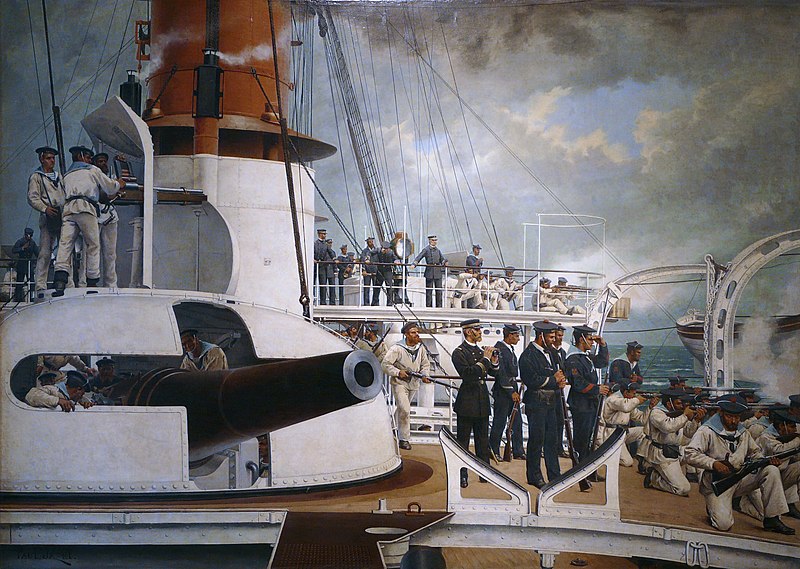
Ironclad Vauban (1882) – Coll. Musee de la marine
There was indeed no real coherence or true classes, despite a distinctive “French style” of battleships. Characteristic with their four single-guns, two main caliber turrets in lozenge, thick military masts, narrow hulls with large tumble homes, tall superstructures…
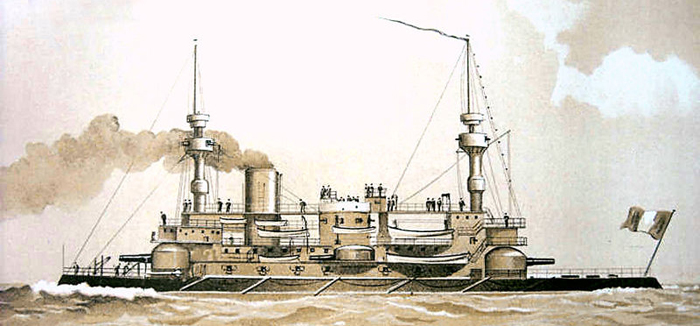
The “Hoche” nicknamed “Grand Hotel”. France entered the war in 1914 with an ageing “fleet of prototypes” of dubious military value compared to the standards of the time. The Hoche was perhaps the most mocked by cartoonists. “What a splendid Target” was presumably said by Kaiser Wilhelm II (1895) then a host at a French Naval Review.
While all other navies followed the British Navy with coherent class of uniform ships, stable with full hulls, low profile, and two double turrets of a single caliber. Production of armour cruisers and cruisers fared not much better, however it was a field that leverage this up: French torpedo boats program, which was quite successful with large coherent class of coastal and sea going models. The blind faith in the revolutionary theories of Young School, led to abandon construction of series of battleships to move towards a destroyers and TBs-based fleet, able to deal with the Royal Navy in an unconventional way.
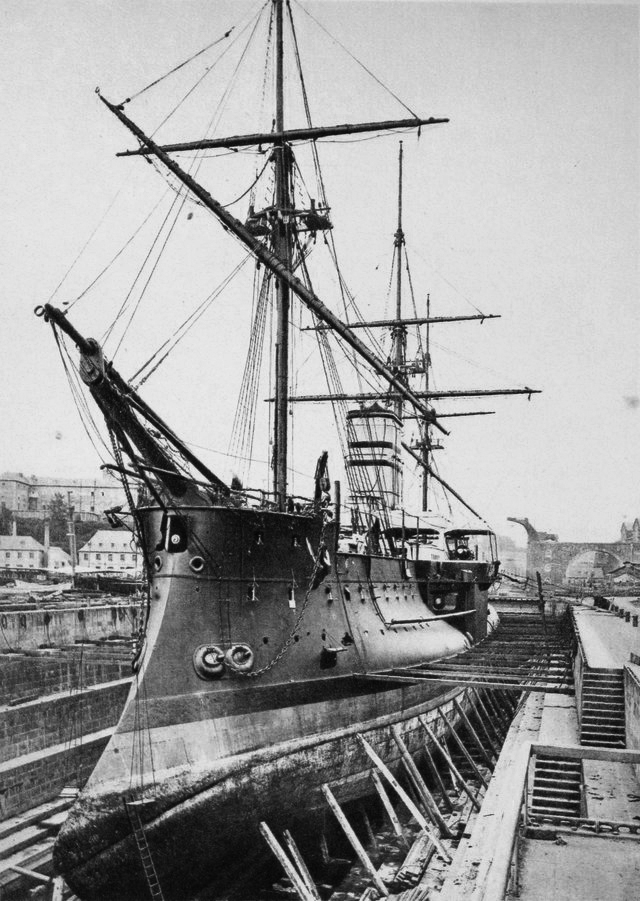
Ironclad Le Redoutable 1876 in Brest – credits: Photo Neurdein – Histoire de la Marine française illustrée, Larousse, 1934.
Despite of all this, in 1914, the French navy still was sure of its power, modernism and effectiveness. By tonnage, in 1885-1895, she was second in the world. As “warming” relationships and collaborations with arch-enemy UK took place, the two marines were still compared as late as 1904, but naval experts rather looked toward the three major rising powers, the German Reich, the US and Japan. It was time to put a breakpoint in these experiments and to return to a traditional standardized fleet in 1904, secured by the signing of the Entente Cordiale between the two old foes.
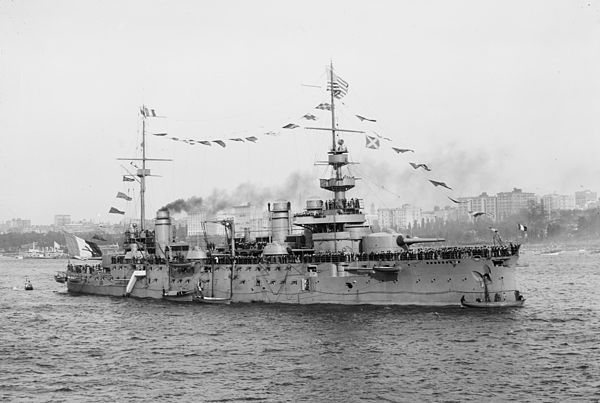
French Battleship Justice (1906) at anchor in the USA – credits USN National Archives
France could then turn to the defense of its colonial empire and take better account of the rising threats in the Mediterranean, the Italian and Austro-Hungarian fleet. But encased in its certainties, instability and waste of public funds, the situation of the navy still at its lowest. In 1906, the first time in years, UK was taking a technological advantage in presenting the Dreadnought.
However by 1908 previous designs in construction were already obsolete, whereas in 1910, the French navy still do not possessed any dreadnoughts or battle cruisers, nut instead a collection of old battleships and cruisers, slow and poorly protected. The only tangible progress came with the late pre-dreadnought of the homogeneous class Patrie, république and Danton, which arrived too late.
Boué de Lapeyrère reforms (1909-1914)
In 1909, Admiral Boue de Lapeyrère, who had had every opportunity to decry the carelessness that had brought down France down to the world’s fourth naval rank, arrived at the Ministry and managed to get his massive plan naval rearmament approved. He Focused on the rapid modernization of the fleet. The plan, which was voted in 1912, involved the construction of 28 dreadnoughts, 10 fast light cruisers (scouts), 52 destroyers, 94 submarines and and 10 gunboats and corvettes. The plan theoretical completion was scheduled in 1920, but was abruptly stopped by August 1914.
This plan included the Courbet class battleships, but also the Bretagne, Normandy and Lyon, the last to be completed between 1916 and 1918-1919. The first adopted the “standard” 305 mm caliber, the second 340 mm and the latest 356 mm. The first two classes were completed in time to be thrown into the fire, but the other were cut short by the consequences of the the 1921 Washington Treaty.
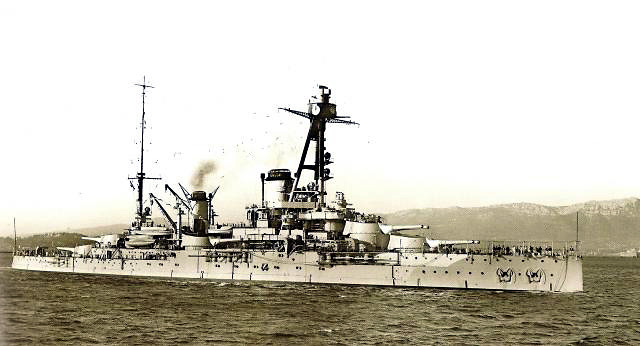
Battleship Courbet in Toulon, modernized in 1932, Illustration by Francis T. Hunter, Coll. Beatty, Jellicoe, Sims & Rodman. (cc)
In August 1914, France returned with a navy composed of old and mismatched ships, but crews were well trained and of high morale despite the poor consideration of the navy, that always passed in second behind the Army. Best proof that without the construction plan being canceled, shipyard workers joined the front, or were converted to the production of guns and shells. The plan had to resume in 1918, but at that date, naval strategy already has gone great lengths the planned ships were already somewhat outdated in design.
Fleet composition in 1914
Battleships
The workforce of this high sea fleet included 25 modern battleships, but only 4 dreadnoughts of the Courbet class, the last (Paris) was being tested at the time of Sarajevo assassination. The three Bretagne were then under construction. The rest of capital ships consisted of pre-dreadnoughts, 6 Danton (1909-1910), the 3 Liberté (1904-1905), 2 République (1903). (Liberté was sunk in 1911 following a boiler explosion, and Jena for the same reasons in 1907).
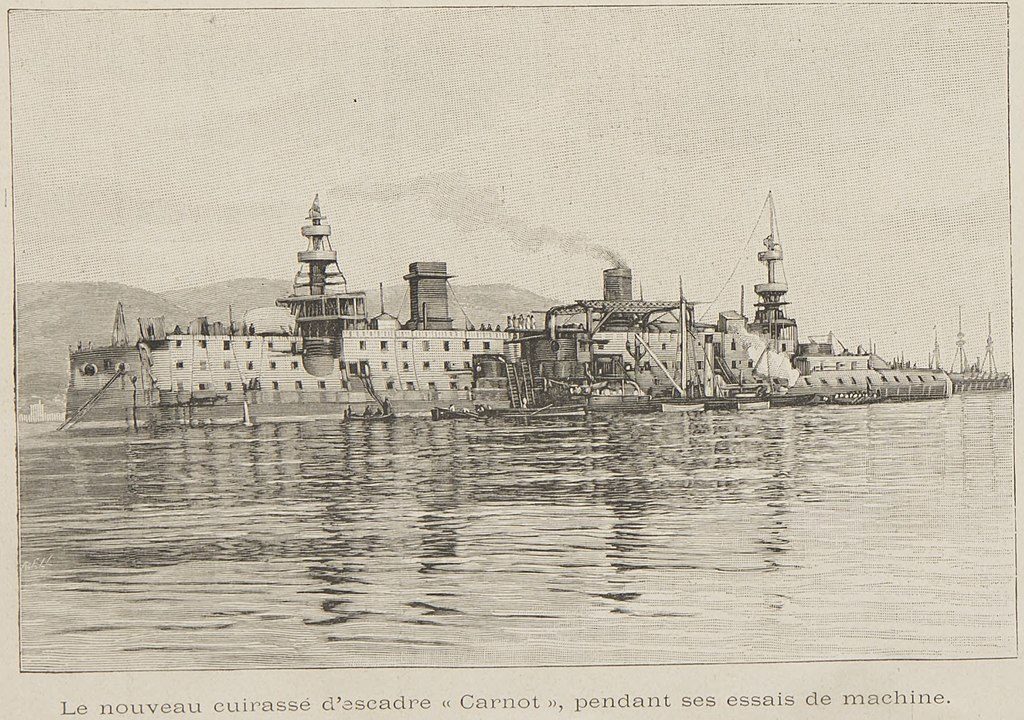
Battleship Carnot in completion and engines trials – Alexandre Bougault coll. (18 January 1896), Engraving by A Bell – L’Illustration, 18 January 1896, No. 2760, p 53. University of California/Hathitrust
Beyond this, is the realm of “collection”. No ship can indeed be formally attached to a particular class, as all differ on armaments, machinery, armour, superstructures arrangements… By chronological order were found the Suffren (1899), the three Charlemagne (roughly similar, 1896), Bouvet (1896), Massena (1895), Jaureguiberry (1893), Carnot (1894), Charles Martel (1893), Brennus (1891), and reserve ships Marceau, Magenta, Neptune, Hoche (1886-1890), thus not counted, but maintained to be quickly serviceable just in case …
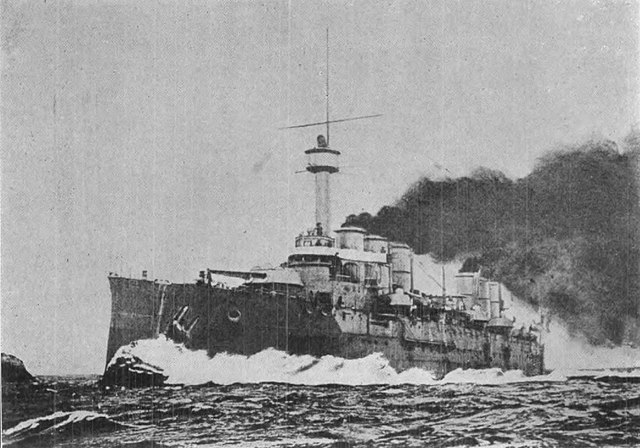
French Cruiser Ernest Renan at full speed circa 1909 – Journal of the American Society of Naval Engineers. Washington, DC: R. Beresford. 21. 1909 (cc)
Armoured Cruisers:
The French fleet in 1914 totalled 19 armoured cruisers, however much more vulnerable than their name let suppose, especially for underwater protection. Most were conceived before the entente cordiale, destined to lead commerce raiding against the British Merchant lines. Nineteen were in operation, which constituted a more homogeneous classes. These were the two Edgar Quinet (1907), Ernest Renan (1906), Jules Michelet (1905), the three Gambetta (1901-03), the four Gloire (1900-1902), the three Dupleix (1900-1902), the three Gueydon (1900), Joan of Arc (1899), Pothuau (1895); The three Admiral Charner (1892-1894) in reserve, and the Dupuy de Lôme.
Protected Cruisers:
These were ten protected cruisers in all, quite old for most (pre-1900) and especially heterogeneous, surviving ships from classes of three units. In 1914 these were the Jurien de la Gravière (1899), Estrées, Chateaurenault, Guichen, D’Entrecasteaux, Cassard, Du Chayla, and Descartes. The Friant was in reserve, as well as Lavoisier, Cosmao and Surcouf, in theory too old to serve effectively (1888-1892), but the Friant and Lavoisier were soon back again into active service after the war erupted such was the lack of ships.
coastal battleships:
Built following the strict coastal defensive stance of the “Young school” these units were almost scaled down battleships, still with heavy caliber pieces. This included the Bouvines (1893), all the others being removed from service because of their age. However the three ancient ironclads of the Terrible class (1881-1885), were removed from the reserve after the war broke out, were completely rebuilt and returned as fire support ships in the Mediterranean.
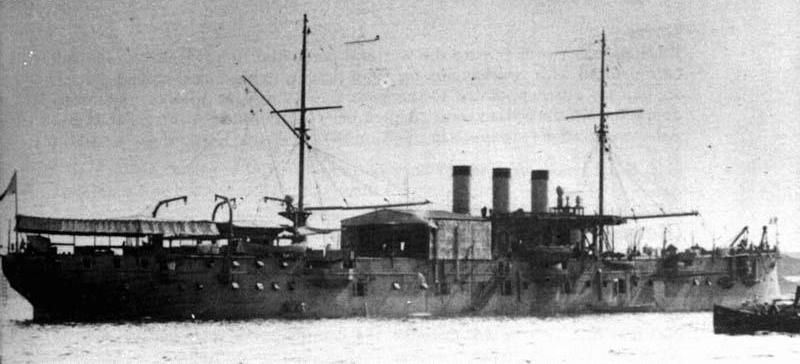
Seaplane carrier La Foudre, an innovative vessel first built as a torpedo-boat mothership. Public Domain (cc)
Torpedo-Cruisers
From concepts dating back to 1885, these ships were of little use in 1914. Many of those who remained in service as gunboats overseas. 6 were active, the two Dunois (1897), (school ship or artillery support), the three D’Iberville, (two used as mine-layers) and La Foudre, a strange torpedo-boat carrier/mothership developed by the young school but not followed by any other navy. At the time or operated as such, she could embark 8 small TBs. It was converted into a a seaplane carrier in 1911, the first of its kind.
TB Destroyers:
Many but of too modest tonnage to venture out of the Mediterranean, these vessels could be compared to the oceanic TBDs of the Germans rather than the British ones. In service were units of the Bisson (6) class, Bouclier (12), Chasseur (4), Voltigeur (2), Spahi (7), dating from 1909, to which were added by August 9, 1914 the four Adventurier built for Argentina and requisitioned. There were also the Branlebas class (10) Claymore (13), Arquebuse (20), Pertuisane (4), Framee (3) and Durandal (3). This total represented 80 ships, but some figures states of 85 units, as we could include 4 requisitioned in 1914, but that only goes for 84.

Torpedo Boats:
First are the modern “high seas TBs” powerful and fast, the Mistral (6), Cyclone (5), and the old Forban, Ariel, Aquilon, Arverne, and Chevalier. Actual destroyers are present in homogeneous, impressive numbers: 75 units of type “38 meters” (1905-1908), 92 of the type “37 meters” (1897-1904) type. Yet this figure is much lower in reality, as between 20 and 50 because many units were withdrawn from the lists and placed in reserve. The ‘126’, which included two classes of 25 and 29 units (1891 to 1895), and 15 of the 35 meter type (1890), had all been removed from the lists, but two remained active, N ° 133 and 158. in total this torpedo force should have been between 100 and 120 units in 1914, all for defensive postings in the French Rivieria.
Submersibles:
In this area, the French were pioneers, although not alone: Whether one thinks of the Spanish Ictíneo I (1860s), the Turtle of Bushnell (1760s), the Faidy sub-bicycle (1830), the Confederate Hunley (1863), among others. Engineer Drzewiecky from Russia, and Laubeuf and Zédé for France were instrumental in this quest, as John Holland was for the Americans and the British. Two schools for thinking, two approaches existed. The Anglo-Saxon one which defined a “true” submarine, as fast underwater as in surface and capable to go deep, and the French and Russian schools preferred instead a “submersible TB”.
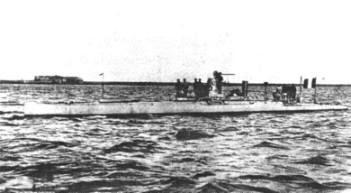
Submarine Narval – Public Domain (cc)
Maxime Laubeuf in particular won an important contract and secured his model for the years to come, the Narval (“Narwhal”), as fast as a TB in surface, but capable to dive quickly and operate underwater for some time, although at slower speeds than the complex Holland types. It allowed to focus less on complex submersion techniques to manufacture destroyers equipped with fillable ballast tanks with air compression systems, electric installation.
Such was influential this design (There was a “before” and “after” the Narval, as most models, including those of Holland, were at least inspired by it at some degree.) that the Germans soon purchased it to produce their first U-boats under licence. This type eventually won and generalized worldwide. The “true submarine” type however will make a return in Germany at the end of the war with the Type XIV and Type XXI, which prefigurated postwar subs until the arrival of the nuclear power.
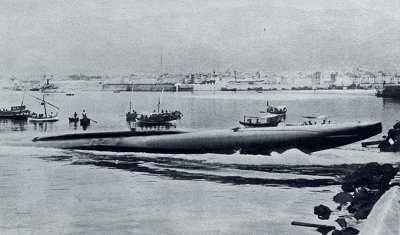
Gustave Zédé, experimental submarine (1894), launched at Toulon. (cc) Public Domain
Less known is the fact than in France, prior to 1914, these two visions existed and competed, encouraged by the Young School. This generated a number of patents of complex engineering and systems which reliability was sometimes questionable. History clearly grants Laubeuf the merit of the first effective, reliable and modern French submersible. The Narval was revolutionary, and won from a subscription, a public contest in 1899.
She was not on the lists in 1909, but deserves attention as well as the old “plongeur” (1863) mentioned higher, closer to a confederate “david” than a real submarine, while the Gymnôte (1888), built by Gustave Zédé, introduced the fins allowing it to dive. It was followed by submersible Zédé by Romazotti, named after the former engineer (1893), the Morse in 1899, followed by the X, Y and Z in 1904-1905.
In 1914, French submarines were quite heterogeneous, combining various classes of ships designed by Laubeuf, Zédé, Romazotti, Maugas, Bertin, and Petithomme. To simplify things let’s talk first about the series: These were the Sirène (4), Farfadet (4), Morse (2), but mostly 20 “Naïade” (widely criticized, they were overly complex and utterly unreliable, accumulating fatal accidents to the point of being nicknamed “Noyade” (“drawning”) by derision by their crews).
They were relatively old (1901-1905), and coastal. Also were commissioned the two Egret (1904), two Circe (1907), six Emerald (1907-1908), 18 Pluviôse (1907-1909), 16 Brumaire (1911 to 1912), the two Clorinde (1913) and Zédé II (1914). To this must be added the Omega prototypes (1905), the single Archimedes, Mariotte, Admiral Bourgeois, Charles Brown (1909-1910). Others will be constructed during the conflict.
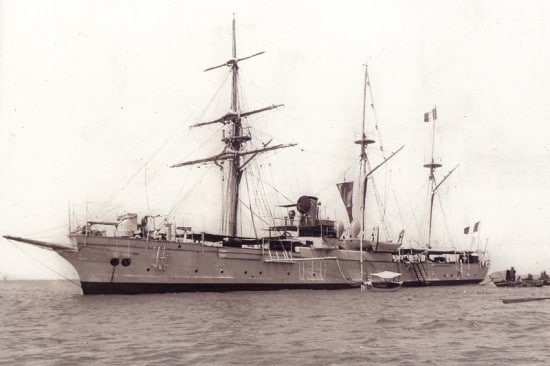
Zelee in 1912. She would fight the Emden in Papeete, French Polynesia – Public Domain (cc)
Miscellaneous:
This category included three composite gunboats of the Surprise class (1895-1899), of which the Zélée was opposed to the cruiser Emden, and the composite corvette Kersaint (1897), plus the 2 riverine gunboats of the Vigilante class (1900), operating in China, as well as the Doudart de la Grée (1909), and scores of other local small units located in Indochina and China, as the Pei Ho (1901), Doucet (1886) and Jasquin (1884).
Tonnage in 1914:
- 26 Battleships
- 35 Cruisers
- 84 Destroyers
- 120 Destroyers
- 120 TBs
- 83 Submarines
- 32 Misc. ships
Part II – Wartime Constructions:
As previously reported, France chooses to strip its shipyards from workers, send on the front line or to manufacture ammunitions (until women replaced them). The activity did not came to a standstill, however, as progress for planned ships continued at a weak pace, often giving way to guns and ammunition manufactured for the front.
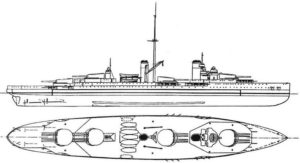
Battleship of the Lion class design. With a 16 x 340 mm broadside, these would have bring much more steel on the target than the British Revenge or Queen Elisabeth class. None was ever completed. We can only dream of what if they had been so, moreover modernized in the 1930s.
Battleships
The constructions of the 1912 ambitious plan continued, and so the Bretagne class of which three were launched in 1915 and 1916 were followed by the five Normandy, well advanced in 1918. But the Washington Treaty and its limitation to 175 000 tonnes for France, condemned them. They could have been chosen to replace the four obsolescent Courbet class, but those were not the choices made, and the most advanced of all, the Béarn, would be later converted into an aircraft carrier. There would have been followed by the impressive Lyon class (16 x 340 mm main guns in four quadruple turrets). There were also battle cruisers projects, designed by engineer Gilles in 1913 and planned for 1914, or those of Durand-Viel, planned for 1915-1916 but which remained as paper projects.
Cruisers
The French cruisers were already outdated in 1914. No new construction in this area had been undertaken since 1903, although the 1912 plan included 12 “scouts”, in line with the kind of ships launched by other marines, very fast and well armed. The class prototype, to be named Lamotte-Picquet, was scheduled for 1915, but the order never came. So, the name will be revived for the next three light cruisers of 1922-1923.
Destroyers
As smaller, less-work intensive ships, a single yard managed to deliver the two Enseigne Roux and Enseigne Gabolde. But the lack of manpower led France to buy 12 Japanese destroyers of the Kaba class, rename Arab class, loaned in 1917.
Submarines
By contrast, submersible construction fared much better with the release of 6 Amphitrite (1915 -16), 3 Bellone (1915-1917), 2 Dupuy de Lome (1915-1916), of 2 Diane (1915), 2 Joessel (1915), 4 Lagrange (1917), 3 Armide (1916 ) and after the armistice of 3 O’Byrne (1919), Maurice Callot (1921) and Pierre Chailley (1921).
Miscellaneous
However, production and conversion of escort units was entrusted to private civilian yards, rescuing a number of small vessels, but also conventional arsenals, including Lorient, Cherbourg, Rochefort, La Seyne (Toulon). Entering service during the war were 6 corvettes of the Marne class (1916-1917), 30 Amiens (1916-1917), the 2 Ailette, 3 Scarpe, 6 Dubourdieu, and Flamand (1917-1918); Gunboats such as the 23 Ardent (1916-1917) class, 9 Luronne/Friponne (1917-1918), the 2 Valiant (1918).
Also were built minesweepers, of the classes Harrow, Granite and Alabaster (16 units), 17 submarine hunters type C101 at the end of the war in 1918-19 in addition to those sent from the USA, and numerous patrol boats, converted tugs, trawlers and coasters, Navarino (12) Bouvines (8), Jacques Coeur (10), Gardon(9), Barbeau (8), Mauviette (30), Hippopotamus (4), Pluvier (15), Aurochs (4), Clameur (6) Athlete (3) and Crabe (12). All returned to civilian service in 1919-1920, but some were still enlisted in the French Navy in 1939. Also worth mentioning were the river gunboat Balny, (same type as the Doudart de la Grée), and 73 light sub-chasers (1916-1918) built in the USA (V1) or France (V41 and V54).
Wartime Constructions:
- 3 Battleships
- 3 Destroyers
- 18 submersibles
- 257 Misc.
Part III: The French navy in operations
Certainly shadowed by the epic British and German clashes of shining, fast battle cruisers, it is generally believed that the French fleet did little at sea in 1914-18. In fact, as a tacit agreement with the British, French assets first operated in the theater that best matched the composition of its fleet, the Mediterranean. She never participated in large naval battles in particular because of the combined weight of the Franco-Italian fleet, that dwarfed the modest Austro-Hungarian fleet, rarely venturing outside the Adriatic or away from the safe harbor of Pola. However, the French took an active part in the bombing of the Dardanelles, loosing several capital ships due to mines. Later other losses amounted because of the U-Bootes at large.
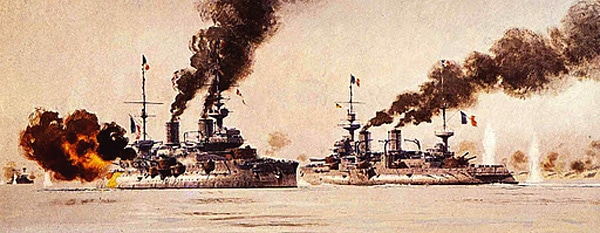
French Battleships in the Dardanelles, 1915, near Anzac cove, taking care of Turkish forts.
The first task of the Mediterranean battle squadron was to escort transport ships carrying troops from the North African Colonies to France, or conducting patrols in the Adriatic Sea to prevent any attacks by the Austro-Hungarian Navy. But above all, the French Navy waged war to roaming German U-boats with patrols and escorts. In December 1916, the fleet bombarded Athens and landed a party of Fusiliers Marins, forcing the pro-German Greek government to change its policies. At the end, most critical losses were three pre-dreadnought battleships, one semi-dreadnought, four armored cruisers, one protected cruiser, twelve destroyers, and fourteen submarines.
WWI French Warships
Battleships
 Terrible class (1885)
Terrible class (1885)
(Terrible), Caiman, Indomptable, Requin
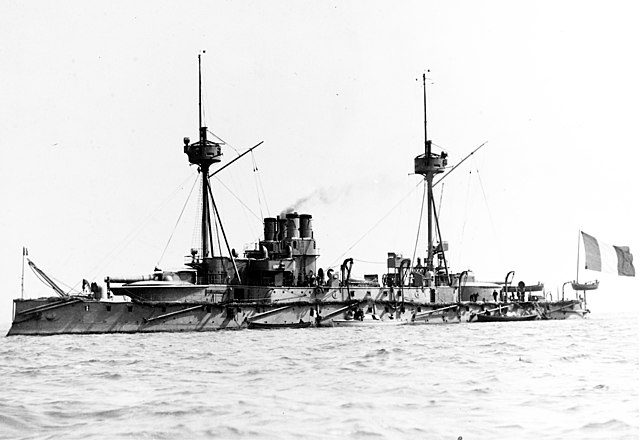
These relatively small barbette ships originally armed with two 16.5 inches/22 M1875 guns were modernized at the turn of the century. Terrible received new 13.4 in guns in 1898, but was discarded in 1911. The other three were still listed as active, but onlt Requin had been reboilered, given new VTE engines and a fully new armament thet three shared the same 10.8 in main guns. The first two were static port defence ships, while Requin did served in the Mediterranean, notably the Suez Canal.
Specs: 7,530 long tons 82.75 x 17.98 x 7.98m (271 ft 6 in x 59 x 26 ft 2 in), 2 shafts VTE, 12 Niclausse fire-tube boilers 8,000+ ihp (Requin 1914), 15 knots (27.8 km/h) crew 300+
Two 10.8 in guns (274 mm), 2× 100 mm (3.9 in), 4× 47 mm (1.9 in) Hotchkiss, 16× 37 mm (1.5 in) Hotchkiss, no TTs. Protection Belt: 203 to 508 mm (8 to 20 in), Barbettes: 457 mm (18 in), Conning tower: 25 mm (0.98 in)
 Hoche (1886)
Hoche (1886)
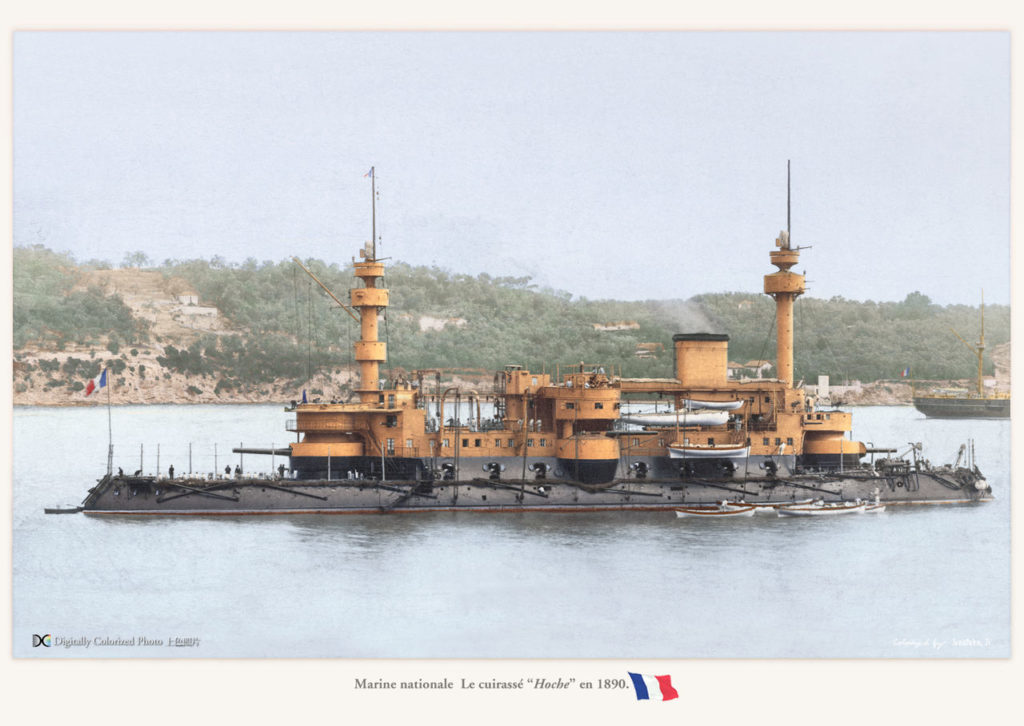
The “splendid hotel” was a unique battleship testing new ideas of the “Jeune Ecole”. She was built over nine years (1881-1890) and thus obsolete when completed. She inaugurated the strong tumblehome, heavy military masts, a new mix of turrets and barbettes with various calibers in lozenge arrengement, something which will stick with French Battleships until the Charlemagne class for some aspects. She had been reboilered in 1898 with new VTE engines and 16 Belleville boilers. Inactive since 1908 (reserve division) she was sunk as target ship in 1913.
 Marceau class (1887)
Marceau class (1887)
Marceau, (Magenta), (Neptune)
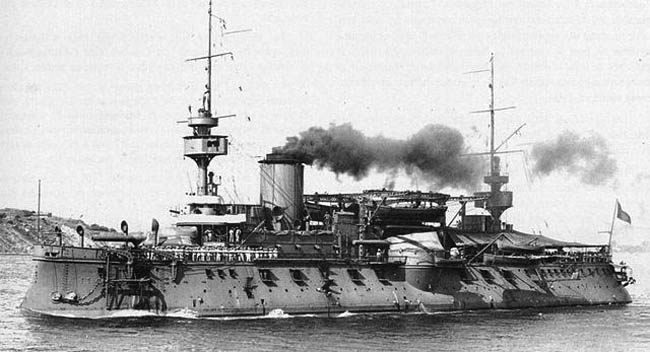
Three larger barbette ironclads with a better seakeeping compared to Hoche, marked differences between them and same very long construction time of ten years, near obsolete when completed. They were caracterized by their much higher freeboard, intended for the Atlantic. Magenta was discarded in 1910 and Neptune in 1913. Marceau was in service in 1914, being the only one reboilered with 16 Niclausse models. But she was used as a floating workshop in WWI, sold 1921. More on the 1890 page.
 Charles Martel class Battleships (1891)
Charles Martel class Battleships (1891)
Brennus, Charles Martel, Jauréguiberry, Carnot, Masséna, Bouvet
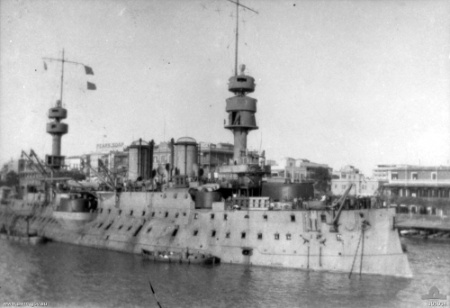
Jaureguiberry in 1915.
Placed there in a very artificial way as all these were based on relatively similar armament and requirements, they were different enough to justify their own individual classes. Compared to the former vessels, they were in active service in 1914, at various degrees. Derived from the Hoche, they had the same basic caracter traits, Brennus being the only one with a twin turret and 13.4 in, the others had singles with a 12-in/45 guns and side turrets with 10.8/45 in guns.
-Brennus was reclassified as training ship from 15 November 1909 (scrapped 1922)
-Charles Martel was in reserve until 1914, recommissioned to become a barracks ship, hulked.
-Carnot was no longer active in 1914, but maintained in reserve to be called at any moment. She was scrapped in 1922.
-Jaureguiberry was active: She escorted troop convoys and supported the French landings during the Gallipoli Campaign (Cape Helles, April 1915) and later was a guardship at Port Said until 1918, and accommodation hulk from 1919 until 1932, BU 1934.
-Masséna was no longer active in 1914 but in 1915, was hulked at Toulon and towed to Cape Helles on 9 November 1915, scuttled to create a breakwater during the evacuation.
-Bouvet was active, took part in the Gallipoli campaign and famously hitting a mine and sinking on 18 March 1915.
 Charlemagne class Battleships
Charlemagne class Battleships
Charlemagne, St Louis, Gaulois

At last the start of a move away from the Jeune Ecole theories, or at last an attempt of better standardization, and for a more conventional design with twin turrets with 12-in guns fore and aft. All three were built much faster in 3-4 years. All were active in WWI: The trio escorted Allied troop convoys in the Mediterranean and were ordered to Tenedos Island, not far from the Gallipoli Peninsula, waiting for a sortie of Goeben. Gaulois became rear admiral of Rear Admiral Émile Guépratte and they took part in the Gallipoli campaign, where she was sunk in December 1916. Saint Louis was also the flagship of the Syrian Squadron, shelling Turkish positions along the Syria-Palestine coast. Charlemagne and St Louis survived the war and were stricken in 1920.
 Henri IV (1899)
Henri IV (1899)
A single and peculiar “battleship” which was another experiment of the Jeune Ecole, this time to demonstrated the advantage of a very low hull for protection. There was a standard freeboard forward, but the aft part of the ship was monitor-like. This, added with the odd choice of single 10.8 in turrets made her quite unique (and the design was never repeated). She was active in WWI, taking part in the Gallipoli Campaign, stricken in 1921 and BU in 1922.
 Iéna (1898)
Iéna (1898)

A spinoff of the Charlemagne class. She was however larger than any previous design, and with a two-tiered secondary armament. Construction time was five years, she entered service in 1902, but did not participated in WWI. The reason ? She was completely devastated by a cordite explosion in 1907, in Toulon. The investigation found a dangerously degrading “poudre B” component of the bagged charge responsible for this.
 Suffren (1899)
Suffren (1899)

The last “classic” French pre-dreadnought of the Jeune Ecole era. She was of a design close to Iéna, but still diverging enough to be her own class. She was larger and heavier, with a modified protection and increased secondary battery. She was active in WWI, taking part in the Dardanelles Attack, hit 14 times by Ottoman artillery. She was sunk while escorting a convoy by U-52 off the Portuguese coast on 26 November 1916.
 République class
République class
République, Patrie
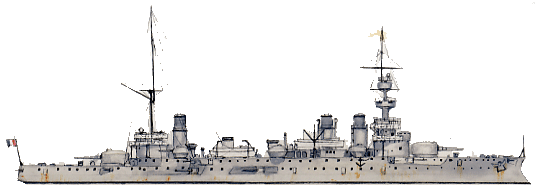
The pre-dreadnought Battleship République marked a real change in French battleship design. It was the first attempt to create a more conventional design, without tumblehome, with a better balanced armament, better speed, reworked armour scheme. Unlike their contemporaries, these battleships had most of their secondary armament in sceondary twin turrets instead of barbettes. In all six were ordered followed the Fleet Law of 1900, with the growing threat of the Imperial German Navy. The follwing six (Liberté) were of a modified design, all by Bertin, from 1896 Central Director of Naval Construction. He milited for years to revise the design of battleships and in particular their vulnerable shallow belt armor (which caused indeed the loss of Courbet and Gaulois in WWI among others).
Thes two battleships were active in WW1, they escorted troopship convoys, were posted to blockade the Austro-Hungarian Navy and took part in the Battle of Antivari and patrolled the south of the Adriatic Sea under threat of Austro-Hungarian U-boats. Patrie was at the Gallipoli campaign (May 1915), République arrived for the evacuation in 1916. They served in Greece, were later based to Mudros until 1918, partial disarmament and conversion as training ships. Patrie went on as a TS until 1936.
Specs: 14,605 tons standard, 133.81 x 24.26 x 8.41 m, 3 shafts VTE, 24 Niclausse boilers, 18,000 shp, 19 knots. Armor: belt 280, turrets 350, CT 300, turrets sec. 152 mm – Armament: 4 x 305, 18 x 162, 25 x 47 mm, 2 TT 457 mm aw. Crew: 825
 Liberté class
Liberté class
Liberté, Justice, Vérité, Démocratie
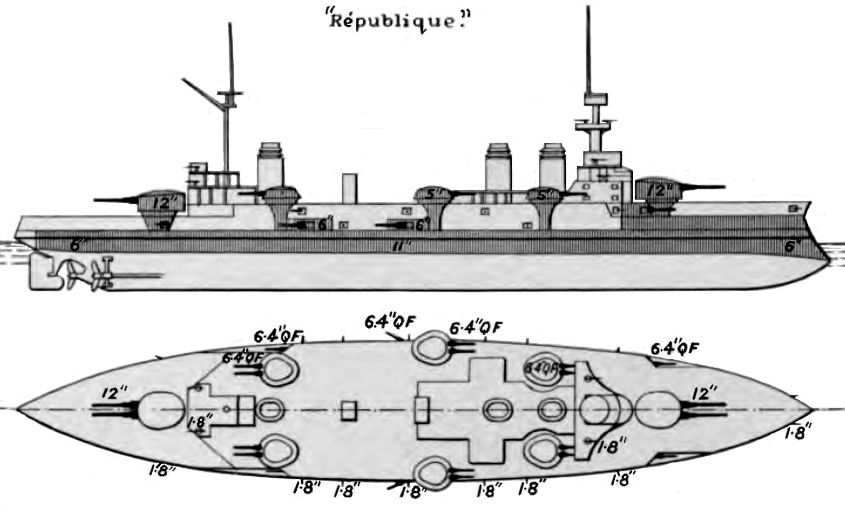
The liberté class were virtually a repeat of the successful République, but with significant differences, enough to make their own class. These four pre-dreadnought battleships were ordered as part of the naval expansion program calling for six new battleships and the second batch was modified to incorporate a heavier secondary battery, something definitely showing up in nearly all navies at the time. They adopted 194 mm (7.6 in) guns, but for the res, remained basically the same, with the same speed of 18 knots (33 km/h; 21 mph).
In peacetime, Liberté was destroyed by an accidental explosion in the same cisrcumstances as Iéna in 1907, also due to propellant charges, in 1911. As the war broke out, the three battleships escorted troopships from North Africa, patrolled the Adriatic and took part in the Battle of Antivari while Vérité was deployed to the Dardanelles in September. From 1916, they were in Greece, to pressure the government to side with the entente and were based in Corfu until 1918. They were back home in 1919 and soon discarded.
Specs: Disp. 14,900 t (135.25 x 24.25 x 8.2 m), 22 Belleville boilers, 17,500 CV (17,300 ihp), 18 kts, RA 8,400 nm. Armament same but 4 ten 194 mm (7.6 in) guns (6×2 in turrets, 4 in casemates). Same protection.
 Danton class
Danton class
Condorcet, Danton, Diderot, Mirabeau, Vergniaud, Voltaire

The Danton class were pre-dreadnoughts at a time France would have built its first dreadnought battleships. Their construction was studied from 1905 and ordered even though in 1906, the launch of HMS Dreadnought completely redrawn the map of naval warfare. Studied had been too far to back down and there was no way to modify the design without causing too much extra delays in the second phase of the massive 1900 naval expansion plan of the French Navy. Thus, the first ship, Voltaire, was laid down in June 1907, and the last, Mirabeau in October 1909, completed in 1911, at a time Britain was already launching its first super-dreadnoughts !
With turbines and a powerful secondary battery they were considered as semi-dreadnought though, and served in the Mediterranean Fleet, deployed in the Adriatic and taking part in the Battle of Antivari, blocking the straits of Otranto and Dardanelles. They also served in the black sea, and sold for scrap after 1918, three being partially modernized in the mid-1920s as TS, but scrapped in the 1930s apart Condorcet in the torpedo school, captured by the Germans in 1942, scuttled in 1944. The lead ship was sunk by U-64 on 19 March 1917.
Specs: Disp. 18 320t, 19 760t FL, Dims. 146,6 x 25,8 x 9.20 m. 4 shafts Parsons turbines, 26 Belleville/Niclausse boilers, 22 500 hp, 19,6 knots, range 4,600 nmi/10 kts. Armed with 4x 305 mm, 12x 240 mm, 17x 75 mm, 10x 47 mm, 2x 457 mm TTs. Armor: Belt 300, turrets 300, blockhaus 300, barbettes 170 mm, Decks 75 mm. Crew: 681
 Courbet class (1911)
Courbet class (1911)
Courbet, France, Jean Bart, Paris

Battleship Courbet – CC colorized by Hirootoko Jr.
In 1910, France was way too late in dreadnought design. Engaged on the construction of the Danton when the British were already launched HMS Dreadnought, French yards were stuck delivering another class of pre-dreadnoughts. Thus, due to the dockyard being occupied there was no way to order dreadnoughts before the Dantons were launched. In between the design of the first French dreadnoughts proceeded quickly, but there were two limitations: The time needed to go for the next caliber at the time, 13.4 in, would have delayed the construction of the new vessels by more than a year, and so in emergency the same old 12-in guns were adopted. In addition the dockyard’s size only allowed a maximal lenght. Compromises in tonnage, powerplant and hull ratio led to the design of battleships with four axial, superfiring twin turrets and two wing turrets like the earlier models. Started in 1910, Courbet, France, Jean Bart, and Paris were completed shortly before the war. They were highly criticized for their poor range due to unsufficient elevation. They will serve both in the first and second world wars although France hit an uncharted rock off Britanny and sank, quite a symbol.
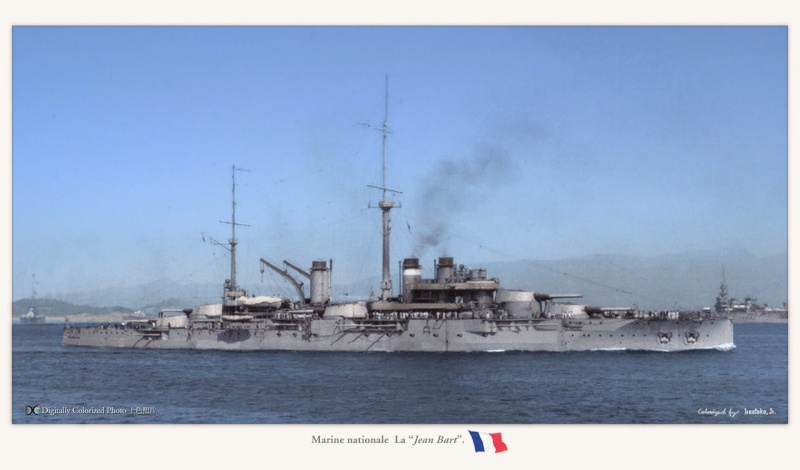
Battleship Jean bart ww1 – CC colorized by Hirootoko Jr.
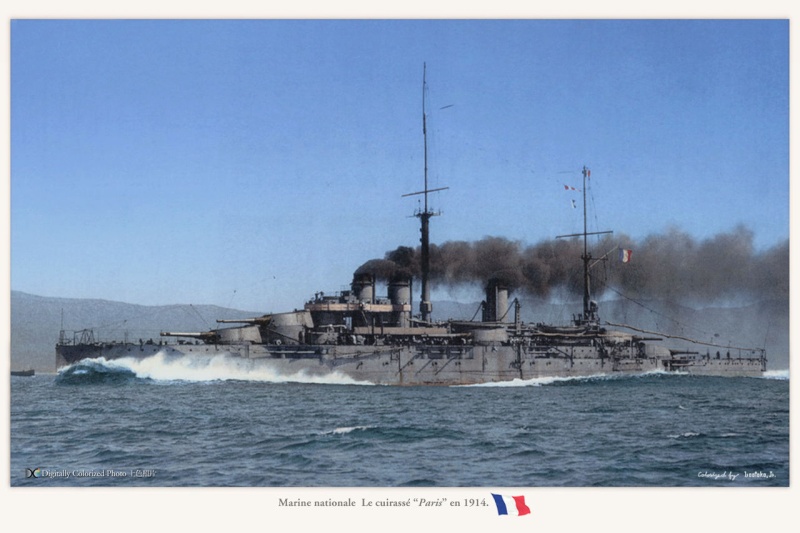
Battleship Paris 1914 – CC colorized by Hirootoko Jr.
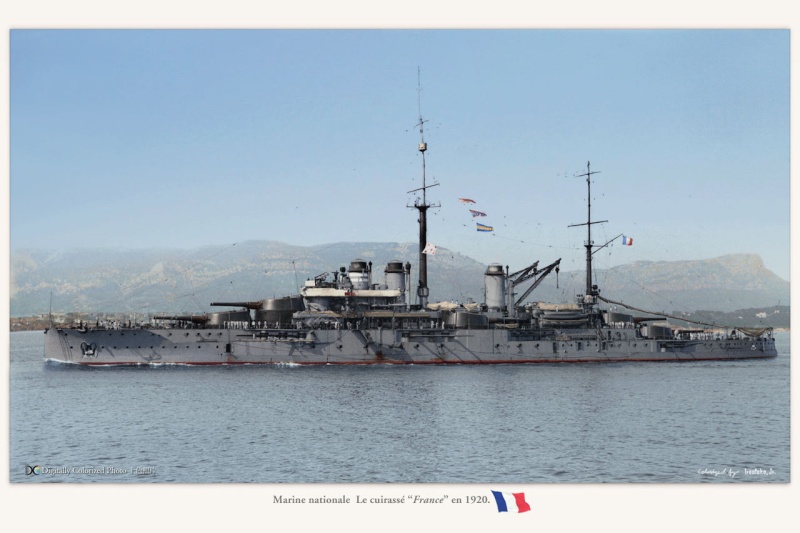
Battleship France WW1 – CC colorized by Hirootoko Jr.
Displacement: 23,475 t (23,104 long tons) normal, 25,579 t (25,175 long tons) full load 166 x 27 x 9.04 m (544 ft 7 in x 88 ft 7 in x 29 ft 8 in)
Installed power: 4 shafts turbines, 18/24 water-tube boilers 28,000 PS (20,594 kW; 27,617 shp) 21 knots range 4,200 nmi/10 kts, crew 1,115, 6 twin 12 in, 22x 5.4 in casemated, four 47 mm, four 450 mm (17.7 in) TTs. Waterline belt 140–250 mm (5.5–9.8 in), Turrets: 250 mm (9.8 in) CT 266 mm (10.5 in).
 Provence class (1913)
Provence class (1913)
Provence, Bretagne, Lorraine
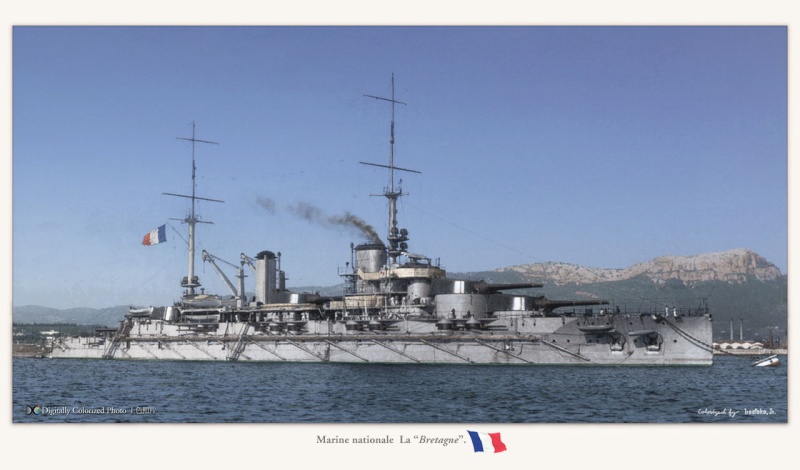
Battleship Bretagne – CC colorized by Hirootoko Jr.
In a hurry after the construction of six Courbet class, fitted with a now obsolete battery with wings turrets, the admiralty wanted to ramp up its game with a more standard configuration of five twin turrets with the new 340mm/45 Modèle 1912 guns (13.4 in) more in touch with contemporary designs. And like them, they were managed in five axial turrets, including one amidships. The major issue however to further development was the available yards dock’s size. It would take two more years for these to built new ones. Rather than waiting, the admiralty preferred to compromise and ordered the new design based on the same hull, which had the maximal size manageable for the existing drydocks, a move which also simplified greatly the design. So the new three battleships ordered according to the Status Naval Law of 1912 three battleships, reaching 26,000 metric tons fully loaded, in a hurry. The Greek Navy also ordered the Vasilefs Konstantinos in June 1914 of the same time for the benefit of a first modern “super-dreadnought”, but she was soon cancelled as the war broke out. The other three were completed in 1915-16, in great difficulty due to labor and material shortages. They were already obsolete as the Royal Navy pointed to the new 15-in caliber, and Germany was following close (with the Bayern), as later the US and Japan, or Italy.
 Normandie class
Normandie class
Normandie, Flandre, Gascogne, Languedoc, Béarn
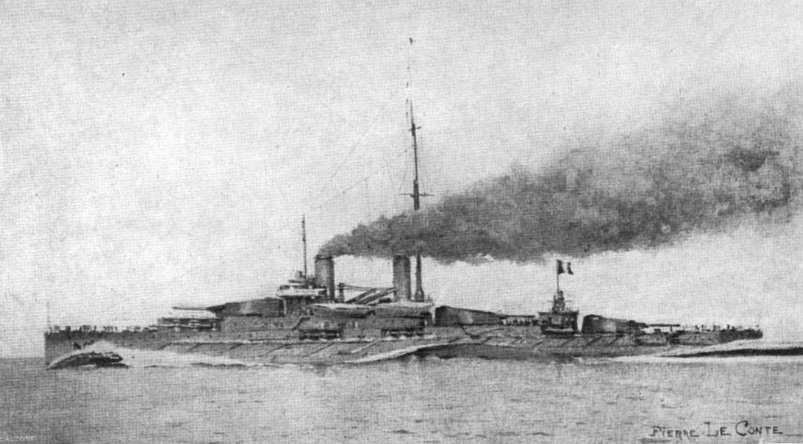
Artist Impression of the Normandie class.
The Normandie class was a bold new step destined to provide France a leap forward, after two series of relatively lackluster battleships. The programme consisted into five dreadnought ordered in 1912–1913: Normandie, Flandre, Gascogne, Languedoc, and Béarn. Due to the time needed to develop a new caliver, likely 15 in (380 mm) at the time, the French decided instead to continue with the trusted 340 mm (13.4 in) for their main battery guns, but betting on numbers to regain the davantage, in three quadruple-gun turrets. This provided twelve guns, rather than ten which was the standard at the time. This quite a bold move with the adoption of quad turrets, first of their kind. The first four also mixed both steam turbines and triple-expansion steam engines for a better fuel efficiency. They would have needed however a yard expansion for their larger hull, a 580 feets hull and a displacement rising at 28,270 t (27,820 long tons) full loaded. They both served in the two world wars. In the second, Bretagne blew up, sunk by the RN at Mesr El Kebir in 1940 and Provence was scuttled in Toulon. Lorraine served with the FNFL, as Paris and Courbet.
Links:
On naval-history.net
The ww1 French Navy on wikipedi
On informationdissemination.net
servicehistorique.sga.defense.gouv.fr

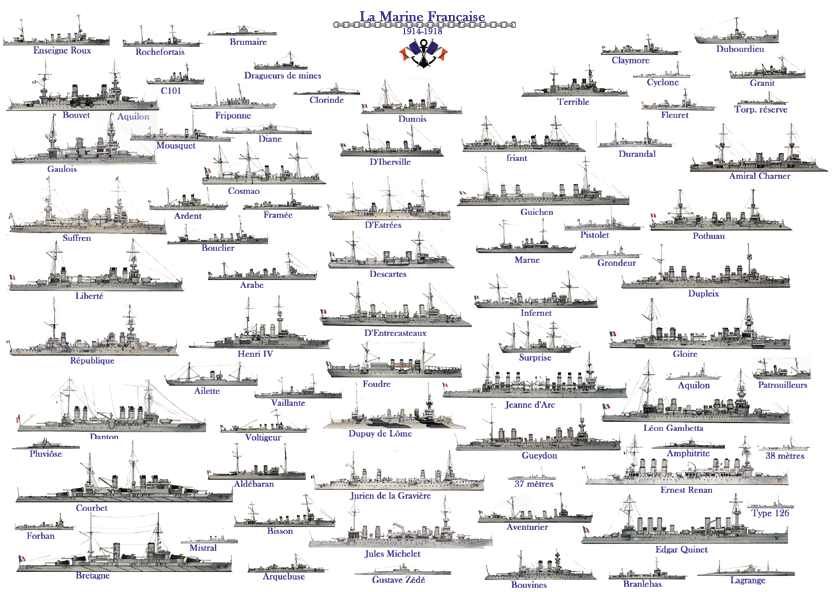
 Latest Facebook Entry -
Latest Facebook Entry -  X(Tweeter) Naval Encyclopedia's deck archive
X(Tweeter) Naval Encyclopedia's deck archive Instagram (@navalencyc)
Instagram (@navalencyc)





 French Navy
French Navy Royal Navy
Royal Navy Russian Navy
Russian Navy Armada Espanola
Armada Espanola Austrian Navy
Austrian Navy K.u.K. Kriegsmarine
K.u.K. Kriegsmarine Dansk Marine
Dansk Marine Nautiko Hellenon
Nautiko Hellenon Koninklije Marine 1870
Koninklije Marine 1870 Marinha do Brasil
Marinha do Brasil Osmanlı Donanması
Osmanlı Donanması Marina Do Peru
Marina Do Peru Marinha do Portugal
Marinha do Portugal Regia Marina 1870
Regia Marina 1870 Nihhon Kaigun 1870
Nihhon Kaigun 1870 Preußische Marine 1870
Preußische Marine 1870 Russkiy Flot 1870
Russkiy Flot 1870 Svenska marinen
Svenska marinen Søværnet
Søværnet Union Navy
Union Navy Confederate Navy
Confederate Navy Armada de Argentina
Armada de Argentina Imperial Chinese Navy
Imperial Chinese Navy Marinha do Portugal
Marinha do Portugal Mexico
Mexico Kaiserliche Marine
Kaiserliche Marine 1898 US Navy
1898 US Navy Sovietskiy Flot
Sovietskiy Flot Royal Canadian Navy
Royal Canadian Navy Royal Australian Navy
Royal Australian Navy RNZN Fleet
RNZN Fleet Chinese Navy 1937
Chinese Navy 1937 Kriegsmarine
Kriegsmarine Chilean Navy
Chilean Navy Danish Navy
Danish Navy Finnish Navy
Finnish Navy Hellenic Navy
Hellenic Navy Polish Navy
Polish Navy Romanian Navy
Romanian Navy Turkish Navy
Turkish Navy Royal Yugoslav Navy
Royal Yugoslav Navy Royal Thai Navy
Royal Thai Navy Minor Navies
Minor Navies Albania
Albania Austria
Austria Belgium
Belgium Columbia
Columbia Costa Rica
Costa Rica Cuba
Cuba Czechoslovakia
Czechoslovakia Dominican Republic
Dominican Republic Haiti
Haiti Hungary
Hungary Honduras
Honduras Estonia
Estonia Iceland
Iceland Eire
Eire Equador
Equador Iran
Iran Iraq
Iraq Latvia
Latvia Liberia
Liberia Lithuania
Lithuania Mandchukuo
Mandchukuo Morocco
Morocco Nicaragua
Nicaragua Persia
Persia San Salvador
San Salvador Sarawak
Sarawak Uruguay
Uruguay Venezuela
Venezuela Zanzibar
Zanzibar Warsaw Pact Navies
Warsaw Pact Navies Bulgaria
Bulgaria Hungary
Hungary

 Bundesmarine
Bundesmarine Dutch Navy
Dutch Navy Hellenic Navy
Hellenic Navy Marina Militare
Marina Militare Yugoslav Navy
Yugoslav Navy Chinese Navy
Chinese Navy Indian Navy
Indian Navy Indonesian Navy
Indonesian Navy JMSDF
JMSDF North Korean Navy
North Korean Navy Pakistani Navy
Pakistani Navy Philippines Navy
Philippines Navy ROKN
ROKN Rep. of Singapore Navy
Rep. of Singapore Navy Taiwanese Navy
Taiwanese Navy IDF Navy
IDF Navy Saudi Navy
Saudi Navy Royal New Zealand Navy
Royal New Zealand Navy Egyptian Navy
Egyptian Navy South African Navy
South African Navy






























 Ukrainian Navy
Ukrainian Navy dbodesign
dbodesign